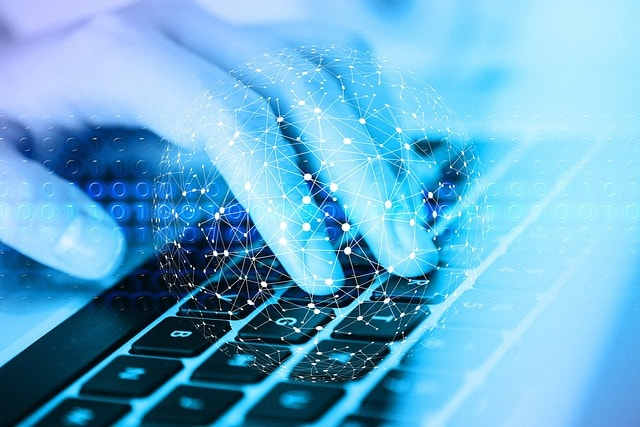Essential Guide…
- Home
- Computer Security
- Information Security…
Organizations face unprecedented levels of cyber risk in today’s digital age. Cybercriminals have taken advantage of remote work adoption and our growing reliance on cloud services. Sensitive data, like customer data, and intellectual property, has become a primary target for information security threats.
The heightened risk emphasizes why there is a need for integrating expert-led oversight to protect sensitive data. Adopting advanced security measures such as 24/7 monitoring and customized security strategies helps organizations protect critical assets and navigate the evolving threat landscape. Implementing more robust cybersecurity and information security also helps organizations maintain compliance with industry standards.
Understanding the Types of Sensitive Data
Sensitive data could harm an individual or organization when exposed. Compromised data often leads to a company’s financial loss and reputational damage. It can also even result in severe legal repercussions. These sensitive data can exist in multiple formats across physical systems, as well as in cloud environments and mobile devices. That is why efforts to protect information and ensure its integrity are critical priorities for businesses.
The key types of sensitive data include:
1. Customer Data
This includes information such as personal identifiers, account credentials, and customer interactions. These are often stored in computer systems or cloud services. Unauthorized disclosure can lead to a security breach, which has the consequences of privacy violations and a loss of customer trust.
2. Financial Data
Financial records are often lucrative targets for cyber attackers. Examples of these types of records are payment details, transaction logs, and financial reports. Securing this data safeguards the integrity of business operations and financial institutions.
3. Intellectual Property (IP)
Proprietary research, trade secrets, and software systems drive innovation within an organization. Protecting these assets safeguards competitive advantage.
4. Healthcare Data
Patient information regulated by frameworks like HIPAA demands strict compliance. Compromises can lead to legal penalties and loss of reputation.
In cybersecurity, data loss prevention (DLP) tools and endpoint detection solutions ensure the confidentiality, integrity, and availability of data across the organization. These services limit access to authorized users. They also enforce strict data encryption and monitor unauthorized access to sensitive systems.
The Foundations of an Effective Information Security Strategy
An effective information security strategy requires a comprehensive framework that integrates both digital and physical security measures. This framework must address all aspects of security, from risk management to incident response, ensuring organizations protect information effectively and align with industry best practices. CyberSense Solutions emphasizes three critical pillars:
1. Risk Management
CyberSense Solutions conducts in-depth assessments to identify vulnerabilities in infrastructure security, cloud systems, and endpoint devices. The actionable intelligence gathered is used to prioritize risks. This helps organizations focus their resources on the most pressing threats.
2. Security Architecture and Policies
Strong security policies form the foundation of a successful information security program, ensuring consistent data protection and risk mitigation. These policies establish guidelines for data protection, access controls, and incident response. CyberSense Solutions design architectures that support these policies while aligning with business objectives.
3. Incident Preparedness
Security incident preparation is critical. In line with industry best practices, CyberSense Solutions develops incident response plans that are highly customized to a client’s needs. These plans, which include detailed workflows for containment, eradication, and recovery, minimize downtime and protect data integrity.
Implementing Key Security Controls to Protect Sensitive Data

Essential for defending against threats to information are Security Controls. These controls must cover both physical security and digital environments. Key measures include:
Data Encryption
Encrypting data stored in computer systems helps prevent attackers from accessing valuable information. This encryption applies to customer databases, desktop computers, and backups stored in data centers.Access Controls
Limiting who can access sensitive systems to only authorized users ensures minimal risk of exposure and prevents unauthorized access to critical assets. This is why we employ identity and access management (IAM) to enhance control across endpoint devices and networks.Data Loss Prevention (DLP)
DLP solutions help prevent unauthorized sharing, transmission, or leakage of sensitive data. These tools monitor and control data in motion (network traffic), data at rest (storage systems), and data in use (endpoint devices). Implementing DLP policies ensures compliance with regulations and protects critical business information from accidental or malicious exfiltration.Endpoint Detection and Response (EDR)
EDR tools can detect and mitigate threats on endpoints, including mobile devices and desktop computers. This method of proactive threat hunting offers a more comprehensive solution than traditional antivirus software.Network Security Tools
Firewalls and intrusion detection systems (IDS) provide an essential line of defense. These tools are deployed as part of infrastructure security service, and they enhance continuous monitoring and bolster the organization’s security posture.
Managing Vulnerabilities and Identifying Risks
A leading cause of security breaches is unsecured software systems and endpoint devices. Effective risk management ensures that organizations can detect and address these weaknesses before attackers exploit them.
CyberSense Solutions’ services include:
Proactive Scanning
Identifying vulnerabilities & weaknesses in computer systems, server configurations, cloud services, and applications. This process ensures that organizations can clearly see their information security posture.Alert Triage
Using actionable intelligence, CyberSense Solutions prioritizes risks by severity and likelihood of exploitation. This allows the organization to focus on the most critical security threats, improving the organization’s security posture.Remediation and Patching
CyberSense Solutions guarantees rapid deployment of patches and updates, strengthening endpoint security by preventing attackers from exploiting vulnerabilities on endpoint devices. This step includes configuration hardening to prevent misconfigurations.
Vulnerability management is a cornerstone of information assurance. By addressing common information security risks, businesses enhance resilience and reduce downtime.
Take Control of Your Vulnerabilities
A proactive approach to vulnerability management is integral to your organization’s security foundation. Discover how CyberSense Solutions can help you strengthen your defenses and enhance your information security posture.
Responding to Security Incidents with an Incident Response Plan
 Organizations unprepared for incidents may face prolonged recovery periods, underscoring the need for well-structured responses. It aims to reduce these impacts and help organizations recover faster.
Organizations unprepared for incidents may face prolonged recovery periods, underscoring the need for well-structured responses. It aims to reduce these impacts and help organizations recover faster.
Effective incident response plans emphasize immediate containment, comprehensive forensic analysis, and tailored recovery strategies, ensuring minimal disruption to operations.
Containment
To prevent the spread of malicious activity, affected systems are isolated. This step often includes cutting off compromised devices from the network.Eradication
Cybersecurity experts remove malware, malicious files, and unauthorized accounts. This ensures that attackers cannot regain access to the system.Recovery
Systems are restored to operational status. CyberSense Solutions ensures business continuity management by verifying system integrity and applying security controls.Lessons Learned & Future Prevention
Conducting a forensic review, documenting findings, and updating security policies based on attack patterns help organizations enhance their incident response capabilities and prevent future breaches.
Incident response involves deep forensic analysis and integration with event management platforms to strengthen infrastructure security. This ensures that security events are documented for future reference and continuous improvement.
Ensuring Compliance with Data Protection Regulations
Compliance with data protection regulations is integral to any organization’s data loss prevention strategy and information security management system (ISMS). Adherence to these regulations prevents legal penalties. It also builds trust with stakeholders by committing to safeguarding sensitive data.
Regulatory requirements often mandate the implementation of robust security measures. Some examples of these measures are data encryption, access controls, and the continuous monitoring of sensitive systems. Compliance is particularly crucial for industries like finance, telecommunications, and healthcare, where breaches can have significant legal and reputational consequences.
Why Ongoing Security Monitoring is Essential

As an organization grows, so do the risks of cyber-attacks. Security threats can remain undetected without continuous monitoring. This leads to unauthorized disclosure, data breaches, and compromised information security programs. As a result, proactive monitoring becomes even more critical in identifying suspicious activities before they escalate into major incidents.
Continuous security monitoring, such as MDR services offered by leading providers, ensures threats targeting infrastructure security and other systems are identified and mitigated in real-time. By combining advanced technologies, automated workflows, and human expertise, organizations can remain vigilant against threats.
Key Features of Effective MDR Services
24/7 Monitoring
Monitoring teams operate around the clock to provide oversight of networks, endpoints, and cloud environments. This guarantees that data security risks and information security threats are identified in real-time.Network Security Monitoring: By pursuing inbound and outbound traffic to detect suspicious activities, data safety in transit is guaranteed.
Endpoint Monitoring: MDR services bolster endpoint security by protecting devices such as laptops and mobile phones, detecting unusual behaviors, and preventing unauthorized access attempts.
Cloud Security Oversight: MDR monitors cloud-based infrastructure to identify misconfigurations or breaches that compromise sensitive systems.
Anomaly Detection
Anomalies in system behavior often signal potential threats. MDR services use entity behavior analytics to detect deviations from established patterns.Cybersecurity services employ artificial intelligence and machine learning algorithms to analyze vast amounts of data. These tools can detect subtle threats that traditional intrusion detection systems might miss.
Examples of anomalies include unexpected login attempts, activities circumventing data loss prevention controls, data exfiltration, or unusual spikes in resource usage within data centers.
Automated Incident Response
Pre-defined workflows and automated playbooks ensure rapid containment and mitigation of threats. Automation reduces response times. This enables security teams to focus on strategic tasks.Containment Measures: Automated protocols isolate affected systems. This prevents lateral movement of malware or unauthorized access.
Remediation Workflows: Coordinated responses across endpoints, networks, and server systems ensure quick eradication of threats with minimal downtime.
Threat Intelligence Integration
Security experts integrate global cyber threat intelligence into their MDR services, providing actionable insights for security teams and the chief information security officer to enhance detection capabilities.Real-time threat feeds provide actionable insights into emerging attack vectors.
Threat intelligence enhances proactive risk management. It ensures that potential vulnerabilities are addressed before they are exploited.
Comprehensive Reporting and Actionable Insights
Every security event, including those identified through endpoint detection, is documented, analyzed, and shared with clients. This is done through detailed reports that include:Descriptions of detected threats and associated risks.
Steps taken to mitigate the incident.
Recommendations for strengthening the organization’s information security posture.
Key Steps for Organizations to Take Today

Organizations must take the following steps to protect information and strengthen their information security programs:
Conduct vulnerability scans to identify weaknesses in systems and infrastructure security measures that may expose the organization to potential security threats.
Deploy advanced security tools such as intrusion detection systems and solutions designed to enhance endpoint security.
Train employees to recognize phishing attempts and other social engineering tactics.
Partner with experienced providers like CyberSense Solutions to support your chief information security officer with expert security consultancy and managed services.
Conclusion
Information security is a fundamental element of a successful business. Protecting sensitive data helps organizations reduce risk, ensure compliance, and build stakeholder trust. CyberSense Solutions offers a suite of services that includes Managed Detection and Response (MDR), vulnerability management, and security consultancy. These services empower businesses to secure critical assets and adapt to an ever-changing threat landscape.
Discover how expert-led strategies can secure your organization’s security posture. Get in touch with us to know more.
Frequently Asked Questions
What is information security, and why is it important?
Information security protects sensitive data and systems. Networks are also protected from unauthorized access, breaches, and disruptions. It ensures data integrity, confidentiality, and availability. This helps organizations maintain compliance, build trust, and prevent costly incidents.
What is Managed Detection and Response (MDR)?
MDR is an expert-recommended security strategy that provides 24/7 monitoring, threat detection, and rapid response to security incidents. CyberSense Solutions’ MDR services protect organizations from advanced threats by combining anomaly detection, automated workflows, and global threat intelligence.
How does CyberSense Solutions ensure compliance with data protection regulations?
CyberSense Solutions provides compliance consultancy to help organizations meet data protection requirements relevant to their operations. Our services include conducting audits, developing tailored policies, and implementing robust security measures such as data encryption and continuous monitoring.
What are the main components of an incident response plan?
An incident response plan includes:
Containment: Isolating affected systems to prevent further damage.
Eradication: Removing malware and closing vulnerabilities.
Recovery: Restoring normal operations and verifying system security.
Post-Incident Review: Analyzing root causes, refining security policies, and strengthening defenses to prevent future incidents
CyberSense Solutions customizes these plans to fit the specific needs of each organization, ensuring rapid and effective responses to security incidents.
How can organizations manage vulnerabilities effectively?
Effective vulnerability management involves proactive scanning, risk prioritization, and timely remediation. CyberSense Solutions provides end-to-end services. The service includes identifying vulnerabilities, applying patches, and strengthening security configurations to reduce the risk of exploitation.
About Us
Contact Info
- [email protected]
- Singapore: 78 Shenton Way, #15-01/01B AIG Building Singapore 079120
- Philippines: 3F Salcedo ONE CENTER, 170 Salcedo St., Legaspi Village San Lerenzo Makati City 1223
Cybersense Solutions Pte Ltd copyright © 2025. All Rights Reserved.